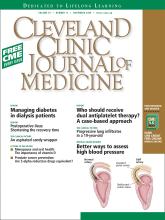Table of Contents
From the Editor
- Low-tech tools, high-pressure stakes
Despite the many ways to introduce inaccuracies in low-tech cuff measurements of blood pressure, the benefits of treating high blood pressure diagnosed this way can be great.
The Clinical Picture
- A 19-year-old man with progressive lung infiltrates
After undergoing induction chemotherapy for acute myeloid leukemia, he developed fever, lung infiltrates, and severe neutropenia. What is the most likely cause?
- Pleural effusion from a candy wrapper
A 60-year-old man presents with worsening shortness of breath and productive cough. Flexible bronchoscopy reveals the surprising cause.
Review
- Current therapies to shorten postoperative ileus
Rather than merely wait for bowel sounds to return after patients undergo surgery, we can try to get the gut working again sooner.
- Managing diabetes in hemodialysis patients: Observations and recommendations
Both uremia and dialysis can complicate glycemic control by affecting the secretion, clearance, and peripheral tissue activity of insulin.
Medical Grand Rounds
- Beyond office sphygmomanometry: Ways to better assess blood pressure
Several new devices provide more information than does traditional sphygmomanometry about the patient’s true hypertensive status, blood pressure control, and risk of end-organ damage.
Review
- Dual antiplatelet therapy in coronary artery disease: A case-based approach
Many patients need the combination of aspirin and clopidogrel (Plavix) or prasugrel (Effient) to reduce their risk of cardiovascular events, as shown in recent trials.
Letters to the Editor
- Menopause, vitamin D, and oral health (August 2009)
Readers comment on how vitamin D deficiency may affect oral health in menopause (August 2009), and on whether drugs for prostate cancer prevention are equivalent (August 2009).
- In Reply: Menopause, vitamin D, and oral health (August 2009)
Readers comment on how vitamin D deficiency may affect oral health in menopause (August 2009), and on whether drugs for prostate cancer prevention are equivalent (August 2009).




